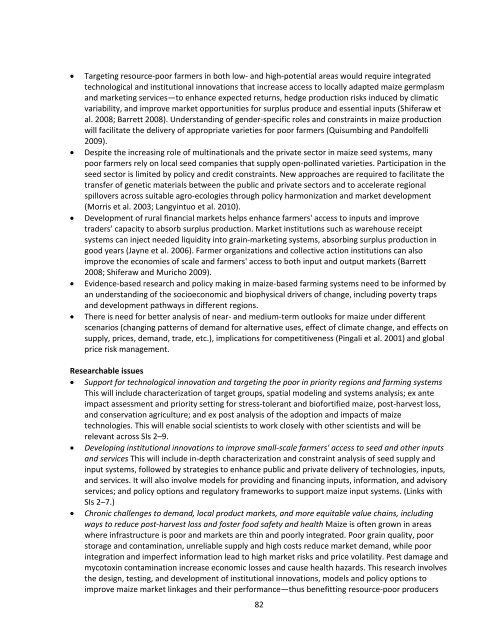Download - Maize
Download - Maize
Download - Maize
You also want an ePaper? Increase the reach of your titles
YUMPU automatically turns print PDFs into web optimized ePapers that Google loves.
Targeting resource‐poor farmers in both low‐ and high‐potential areas would require integrated<br />
technological and institutional innovations that increase access to locally adapted maize germplasm<br />
and marketing services—to enhance expected returns, hedge production risks induced by climatic<br />
variability, and improve market opportunities for surplus produce and essential inputs (Shiferaw et<br />
al. 2008; Barrett 2008). Understanding of gender‐specific roles and constraints in maize production<br />
will facilitate the delivery of appropriate varieties for poor farmers (Quisumbing and Pandolfelli<br />
2009).<br />
Despite the increasing role of multinationals and the private sector in maize seed systems, many<br />
poor farmers rely on local seed companies that supply open‐pollinated varieties. Participation in the<br />
seed sector is limited by policy and credit constraints. New approaches are required to facilitate the<br />
transfer of genetic materials between the public and private sectors and to accelerate regional<br />
spillovers across suitable agro‐ecologies through policy harmonization and market development<br />
(Morris et al. 2003; Langyintuo et al. 2010).<br />
Development of rural financial markets helps enhance farmers' access to inputs and improve<br />
traders’ capacity to absorb surplus production. Market institutions such as warehouse receipt<br />
systems can inject needed liquidity into grain‐marketing systems, absorbing surplus production in<br />
good years (Jayne et al. 2006). Farmer organizations and collective action institutions can also<br />
improve the economies of scale and farmers' access to both input and output markets (Barrett<br />
2008; Shiferaw and Muricho 2009).<br />
Evidence‐based research and policy making in maize‐based farming systems need to be informed by<br />
an understanding of the socioeconomic and biophysical drivers of change, including poverty traps<br />
and development pathways in different regions.<br />
There is need for better analysis of near‐ and medium‐term outlooks for maize under different<br />
scenarios (changing patterns of demand for alternative uses, effect of climate change, and effects on<br />
supply, prices, demand, trade, etc.), implications for competitiveness (Pingali et al. 2001) and global<br />
price risk management.<br />
Researchable issues<br />
Support for technological innovation and targeting the poor in priority regions and farming systems<br />
This will include characterization of target groups, spatial modeling and systems analysis; ex ante<br />
impact assessment and priority setting for stress‐tolerant and biofortified maize, post‐harvest loss,<br />
and conservation agriculture; and ex post analysis of the adoption and impacts of maize<br />
technologies. This will enable social scientists to work closely with other scientists and will be<br />
relevant across SIs 2–9.<br />
Developing institutional innovations to improve small‐scale farmers' access to seed and other inputs<br />
and services This will include in‐depth characterization and constraint analysis of seed supply and<br />
input systems, followed by strategies to enhance public and private delivery of technologies, inputs,<br />
and services. It will also involve models for providing and financing inputs, information, and advisory<br />
services; and policy options and regulatory frameworks to support maize input systems. (Links with<br />
SIs 2–7.)<br />
Chronic challenges to demand, local product markets, and more equitable value chains, including<br />
ways to reduce post‐harvest loss and foster food safety and health <strong>Maize</strong> is often grown in areas<br />
where infrastructure is poor and markets are thin and poorly integrated. Poor grain quality, poor<br />
storage and contamination, unreliable supply and high costs reduce market demand, while poor<br />
integration and imperfect information lead to high market risks and price volatility. Pest damage and<br />
mycotoxin contamination increase economic losses and cause health hazards. This research involves<br />
the design, testing, and development of institutional innovations, models and policy options to<br />
improve maize market linkages and their performance—thus benefitting resource‐poor producers<br />
82

















